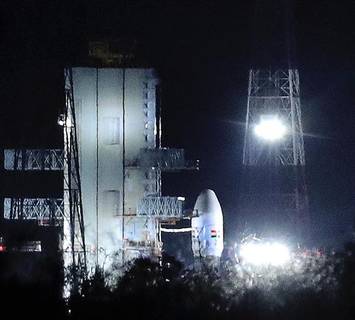Chandrayaan-2 to be launched on July 22
09:16AM Thu 18 Jul, 2019

The Indian Space Research Organisation ISRO tweeted on July 18 morning that Chandrayaan-2 will be launched on July 22 at 2.43 p.m.
The launch was earlier scheduled for July 15 but was called off just an hour before take-off, due to what ISRO said was a technical snag.
The mission includes India's first lander and rover, which are slated to land on moon on September 6. ISRO has chosen an unexplored site at the lunar south pole where no country has been before.
ISRO is yet to publicly share any details on the hitch that was noticed just an hour before the scheduled launch at 2.51 a.m. on July 15. Asked if the glitch related to the GSLV-MkIII launch vehicle, ISRO’s spokesman declined to comment, citing the ‘classified’ nature of expert committee findings.
A NOTAM (notice to airmen) is routinely issued ahead of all rocket and missile launches to notify aircraft pilots [and ships] to enable them to avoid using that route during the specified period.
A third NOTAM for the GSLV-MkIII/M1 indicated an imminent launch during July 20-31 between 2 p.m. and 3.30 p.m. IST. But ISRO’s spokesman said he would not endorse the information to avoid ‘causing any confusion’.
Earth phase may shrink
Chandrayaan-2 is to be India’s first lander-rover mission to the Moon as a sequel to the first orbiting mission of 2008. India also hopes to be the first country to land at the lunar south pole.
The landing has been planned for September 6, or the next day, almost a month after the spacecraft nears the Moon and starts orbiting it.
The spacecraft is designed to go around Earth for 17 days in increasingly bigger loops. In the process it makes use of Earth’s gravity to build up power and saves some fuel.
Earth phase cut?
With the delay in the launch, ISRO may shrink the original 17-day period that the spacecraft was set to go around the Earth in increasingly higher orbits before being put on course to the Moon. A senior scientist said going by the experience of Chandrayaan-1 and the Mars Orbiter Mission of 2013, there was enough cushion in the mission to reduce the number of Earth orbits. - and later even around moon (28 days). A reduced number of earth orbits could make up for the lost days.
However, the day it must leave earth and the day it must enter moon's orbit cannot be touched, so as to keep the landing position and schedule intact, the scientist emphasised.
(Launch vehicles and orbiting satellites are built to be as fuel efficient as possible for good performance.)
As to why glitches show up so late in the mission, the same scientist said all systems pass tests done individually, on ground, and it is difficult to predict if they may behave differently in an integrated state.
This is also the first operational or working flight for the GSLV-MkIII rocket, which has flown well only twice before. With more flights behind it, there would have been more information on its pattern, said another scientist.
An uprated and human certified MkIII will be used to take astronauts to space around 2022, but after two crewed flights.
Source: The Hindu











